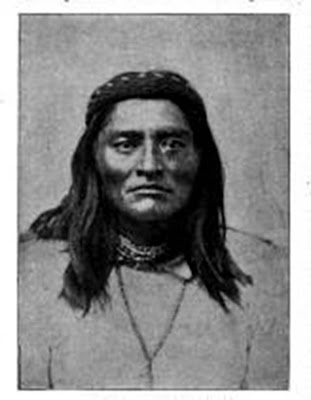
These are the portraits of some of the very first Arizonans. The handbook to Arizona of 1878 by Richard Josiah Hinton quotes: “From the accounts of Father Garcia, who accompanied an expedition in 1774, it appears that the tribes on the Gila and lower Colorado, including the Yumas, Cocopahs, Pimas, Maricopas and Papagoes, then numbered over 25,000 ; they do not now much exceed 10,000. The tribes now inhabiting the Colorado river below the Great Bend are, commencing at its mouth, the Cocopahs, Yumas, Chemehuevis, Mojaves, and Pah-Utes. The Hualapais are in the adjacent mountains of Mojave county”.
The same handbook lists the tribes that at that moment lived in Arizona:
1. The Yumas and Mojaves have a reservation on the Colorado river above La Paz.
2. Apache-Mojaves inhabited a section of country east of the Colorado.
3. The Hualapais, or Wallapais… live in the mountains east of Mojave.
4. The Pah-Utes and Savints are not numerous, and they live on both sides of the Colorado canon. And speaking about Savints the author says:
“Very few whites have ever seen these Indians, or this remarkably secluded valley. Those that have been there were kindly treated, and furnished with blankets and food.”It is so true Billy Wilder sentence: No good deed goes unpunished.
5. The Pimas have a reservation on the Gila river… They have always been at peace with the whites.
6. The Papagoes have a reservation on the Santa Cruz river… their settlements extend some distance into Sonora. They are about 6,000, and occupy 800 houses, many of them adopting the habits and dress of the Mexicans.
 7. The Aravaipa branch of the Apaches lived north of the Gila river.
7. The Aravaipa branch of the Apaches lived north of the Gila river.8. The Tontos lived west and north of them, and the Coyoteros lived east… laid the country under contribution from the Gila south far into Mexico, and east to the San Pedro river. The autor says that
"The Tontos were among the last to surrender, and before they did so most of the tribe were killed.” “They are inferior, physically and mentally, to the other branches of the Apaches; hence their name Tonto, which in Spanish means fool.They, too, live on the reservation at the San Carlos.
9. The Coyoteros lived in the White mountains… They have been moved to the San Carlos much against their will.
10. The Chiricahuas lived mostly in the Chiricahua and Dragoon mountains, and raided from the San Pedro to the Rio Grande and south far into Sonora and Chihuahua, when they finally made peace they were coaxed on the reservation and given their own terms. About a year and a half ago these Indians were moved to the San Carlos reservation, except a small portion under a sub-chief named Pionsenay, numbering about thirty warriors, who refused to go…
 11. The Coco-Maricopas are represented…. as occupying the country south of the river Gila for 150 miles in length from its mouth upwards… These people then consisted of three tribes: the Yumas, the Cocopahs, and the Maricopas.
11. The Coco-Maricopas are represented…. as occupying the country south of the river Gila for 150 miles in length from its mouth upwards… These people then consisted of three tribes: the Yumas, the Cocopahs, and the Maricopas.12. On the east side of the Colorado, near the line between Utah and Arizona, is a tribe of Piutes called the Kwai-an-ti-kwok-ets, numbering forty-seven persons.
13. The U-in-ka-rets dwell among the mountains of that name in northern Arizona, and number about sixty. The Sheav-wits inhabit the plateau of that name in northern Arizona, and number about 180.
 14. The Hualapais now inhabit in a wandering way the greater part of the mountain region of Mojave county and the western edge of Yavapai, and are said to number only about 600...
14. The Hualapais now inhabit in a wandering way the greater part of the mountain region of Mojave county and the western edge of Yavapai, and are said to number only about 600...15. The Pimas… number, with the Maricopas, 4,316. When first found by the Spaniards… they resided in settled villages, which they still occupy.
16. On the White Mountain Reservation are 4,459 Apaches of various tribes, viz: 1,512 Coyoteros, 1,051 Phials and Arivaipas, 629 Tontos, 207 Chiricahuans, 352 Apache-Yumas, and G18 Apache-Mojaves.
17. The Navajo Reservation, by treaty of June 1st, 1868, is located in the north-east corner of Arizona and adjacent portion of New Mexico; it comprises an area of 5,200 square miles, or 3,328,000 acres.
18. The Moqui occupy seven villages, or " pueblos," east of the Colorado-Chiquito and Painted Desert.
The scholars think that some of these Indian Tribes were related to the habitants of the Northeast of Mexico and for sure are related to Navajoes and other tribes that live today in the North of Mexico in the States of Chihuahua, Sonora and Baja California.

With such a history I think is very odd that Arizona´s government pronounces a law based on the appearance of the people and even bans the studies about minority groups to control illegal immigration. I know that recall to the unfair historic relationship between Whites and Indians is a clichéd argument, but don´t you think could be other kind of laws to restrain or control illegal immigration? Asking “paper please” to brownish or other facial features people is an strategy more appropriated to a totalitarian regime than to the Democratic Super Power Nation USA is.





